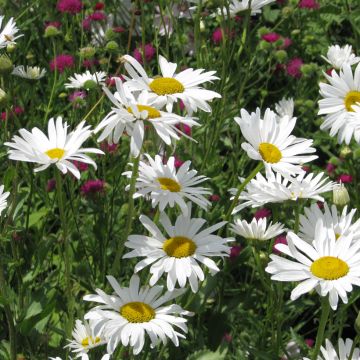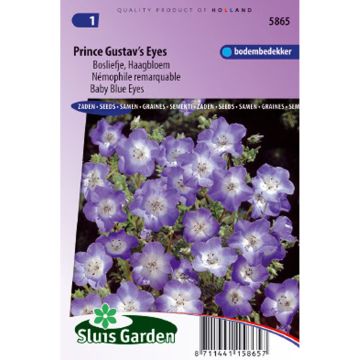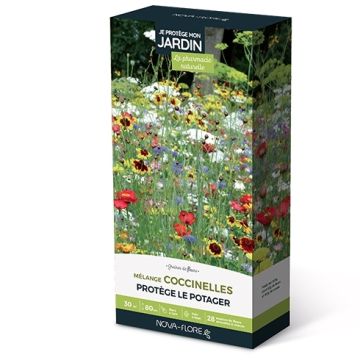

Organic Single Mix Edible Chrysanthemum Seeds - Chrysanthemum coronarium
Organic Single Mix Edible Chrysanthemum Seeds - Chrysanthemum coronarium
Chrysanthemum coronarium Single Mix BIO
Daisy
This item cannot be shipped to the selected country
Dispatch by letter from €3.90
More information
Schedule delivery date,
and select date in basket
This plant carries a 6 months recovery warranty
More information
We guarantee the quality of our plants for a full growing cycle, and will replace at our expense any plant that fails to recover under normal climatic and planting conditions.
Seed-only orders are dispatched by sealed envelope. The delivery charge for seed-only orders is €3.90.
Does this plant fit my garden?
Set up your Plantfit profile →
Description
The 'Polar Star' Crested Chrysanthemum or Chrysanthemum carinatum 'Polar Star' is an annual plant often called Tricolour Daisy because of the different colours present on the flower.
The flower has the shape of a Daisy, which is called a head.
Its centre is composed of tiny tubular flowers which appear brown when closed. These flowers will gradually open in a circular fashion and reveal their yellow stamens. The outer part of this Daisy is composed of ligulate flowers, which means that part of it has transformed into a long white petal. A touch of yellow at the base of this petal seems to encircle the flower's centre.
The dominant white colour of the flower, highlighted by yellow and brown, is the appeal of this Tricolour Chrysanthemum (in Latin, Chrysanthemum tricolour).
Ismelia carinata, Ismelia versicolor, and Matricaria carinatum are synonyms of its name that you may come across here or there, but rest assured we are referring to the same plant.
It is a bushy plant that is not afraid of cold weather and can be sown d, directly in place in April-May.
Standing at 75 cm (29.5 in) tall, it integrates perfectly into a bed of perennial plants, completing the range of colours. Sown in a pot provides a long-lasting solution for decorating the terrace and balcony. Excellent vase life will allow you to create beautiful field bouquets from June to September.
Growing and adapting to all soil types is straightforward while preferring a sunny exposure.
As an ecological gesture: When sowing the Crested Chrysanthemum in your garden, you attract pollinating insects that will enjoy its nectar and thereby promote your garden's ecosystem.
Report an error about the product description
Flowering
Foliage
Plant habit
Botanical data
Chrysanthemum
coronarium
Single Mix BIO
Asteraceae
Daisy
Glebionis coronaria Single Mix, Xantophtalmum coronarium, Glebionis roxburghii, Chrysanthemum coronarium, Chrysanthemum roxburghii
Cultivar or hybrid
Other Chrysanthemum seeds
Planting and care
Easy to grow, Chrysanthemum coronarium thrives in sunny, light, fresh, well-drained soil.
Sow your seeds in pots or cups in March-April. Cover the seeds with a thin layer of compost. Place your seedlings in a warm place at a temperature of around 18°C. It generally takes 5 to 10 days for the seeds to emerge. Once the plants are strong enough and there is no risk of frost, plant them in the garden. You can also sow your edible Chrysanthemums directly in the ground, in loosened soil, from May to June, once the last frosts have passed. Thin out your seedlings, keeping only the most developed plants every 30 to 40 cm.
To use the leaves as mesclun, a distance of 20 cm between your plants is sufficient. By staggering your sowings every three weeks, you can extend the semi-sowing period until August.
Watch out for slugs and snails, which love these young shoots.
Sowing period
Intended location
This item has not been reviewed yet - be the first to leave a review about it.
Flower seeds
Haven't found what you were looking for?
Hardiness is the lowest winter temperature a plant can endure without suffering serious damage or even dying. However, hardiness is affected by location (a sheltered area, such as a patio), protection (winter cover) and soil type (hardiness is improved by well-drained soil).

Photo Sharing Terms & Conditions
In order to encourage gardeners to interact and share their experiences, Promesse de fleurs offers various media enabling content to be uploaded onto its Site - in particular via the ‘Photo sharing’ module.
The User agrees to refrain from:
- Posting any content that is illegal, prejudicial, insulting, racist, inciteful to hatred, revisionist, contrary to public decency, that infringes on privacy or on the privacy rights of third parties, in particular the publicity rights of persons and goods, intellectual property rights, or the right to privacy.
- Submitting content on behalf of a third party;
- Impersonate the identity of a third party and/or publish any personal information about a third party;
In general, the User undertakes to refrain from any unethical behaviour.
All Content (in particular text, comments, files, images, photos, videos, creative works, etc.), which may be subject to property or intellectual property rights, image or other private rights, shall remain the property of the User, subject to the limited rights granted by the terms of the licence granted by Promesse de fleurs as stated below. Users are at liberty to publish or not to publish such Content on the Site, notably via the ‘Photo Sharing’ facility, and accept that this Content shall be made public and freely accessible, notably on the Internet.
Users further acknowledge, undertake to have ,and guarantee that they hold all necessary rights and permissions to publish such material on the Site, in particular with regard to the legislation in force pertaining to any privacy, property, intellectual property, image, or contractual rights, or rights of any other nature. By publishing such Content on the Site, Users acknowledge accepting full liability as publishers of the Content within the meaning of the law, and grant Promesse de fleurs, free of charge, an inclusive, worldwide licence for the said Content for the entire duration of its publication, including all reproduction, representation, up/downloading, displaying, performing, transmission, and storage rights.
Users also grant permission for their name to be linked to the Content and accept that this link may not always be made available.
By engaging in posting material, Users consent to their Content becoming automatically accessible on the Internet, in particular on other sites and/or blogs and/or web pages of the Promesse de fleurs site, including in particular social pages and the Promesse de fleurs catalogue.
Users may secure the removal of entrusted content free of charge by issuing a simple request via our contact form.
The flowering period indicated on our website applies to countries and regions located in USDA zone 8 (France, the United Kingdom, Ireland, the Netherlands, etc.)
It will vary according to where you live:
- In zones 9 to 10 (Italy, Spain, Greece, etc.), flowering will occur about 2 to 4 weeks earlier.
- In zones 6 to 7 (Germany, Poland, Slovenia, and lower mountainous regions), flowering will be delayed by 2 to 3 weeks.
- In zone 5 (Central Europe, Scandinavia), blooming will be delayed by 3 to 5 weeks.
In temperate climates, pruning of spring-flowering shrubs (forsythia, spireas, etc.) should be done just after flowering.
Pruning of summer-flowering shrubs (Indian Lilac, Perovskia, etc.) can be done in winter or spring.
In cold regions as well as with frost-sensitive plants, avoid pruning too early when severe frosts may still occur.
The planting period indicated on our website applies to countries and regions located in USDA zone 8 (France, United Kingdom, Ireland, Netherlands).
It will vary according to where you live:
- In Mediterranean zones (Marseille, Madrid, Milan, etc.), autumn and winter are the best planting periods.
- In continental zones (Strasbourg, Munich, Vienna, etc.), delay planting by 2 to 3 weeks in spring and bring it forward by 2 to 4 weeks in autumn.
- In mountainous regions (the Alps, Pyrenees, Carpathians, etc.), it is best to plant in late spring (May-June) or late summer (August-September).
The harvesting period indicated on our website applies to countries and regions in USDA zone 8 (France, England, Ireland, the Netherlands).
In colder areas (Scandinavia, Poland, Austria...) fruit and vegetable harvests are likely to be delayed by 3-4 weeks.
In warmer areas (Italy, Spain, Greece, etc.), harvesting will probably take place earlier, depending on weather conditions.
The sowing periods indicated on our website apply to countries and regions within USDA Zone 8 (France, UK, Ireland, Netherlands).
In colder areas (Scandinavia, Poland, Austria...), delay any outdoor sowing by 3-4 weeks, or sow under glass.
In warmer climes (Italy, Spain, Greece, etc.), bring outdoor sowing forward by a few weeks.





















































